
Hackers Beware
.pdf
SNMP Authentication
The Authentication header contains two elements: a version number and the community. An SNMP community is the pairing of an SNMP agent with some arbitrary set of SNMP application entities. Each community is named by an arbitrary string called the community name. An SNMP message originated by an SNMP application entity that in fact belongs to the SNMP community named by the community component of a message is called an authentic SNMP message. If an SNMP element receives an SNMP message from an SNMP Manager, and the version number, community string, and IP address match those stored in the agents community profile, the PDU is processed.
There are two levels of community access. A community string can be assigned read-only access or read/write access. A matching read-only community enables the get functions to be executed on the agent, and matching the write-access community string enables the use of the SetRequest PDU. Community strings are a text convention and are transmitted in clear text. The standard default values of most SNMP implementations are public (RO) and private (RW). Many devices automatically default to the values, and many network administrators automatically accept and use these values in their SNMP systems. As we will see in the next section, this community concept creates a great opportunity for attackers to see into and disrupt network devices.
How the Exploit Works
SNMP was designed back when there was a limited number of computers on the Internet. In RFC 1157, which defines SNMP, under the heading “Security Issues,” the complete section reads as follows: “Security issues are not discussed in this memo.” This pretty much sums up the attention given to security issues in the late 80’s and early 90’s.
Because the community name is a text field, and many hardware devices do not log queries sent to invalid SNMP communities, it is a simple game of brute force guessing to gain those community names. Even more astonishing than that is the number of devices that default to the public, private, or write community names. Having attended several Network Management classes in the mid 90’s, the subject of using community names other than the standard defaults was never once discussed. Admin guides and examples always use these names, and most administrators seem to adopt them as their own.
“Hackers Beware “ New Riders Publishing |
690 |
Imagine what the attacker can do after he has obtained the default community names from a packet sniff or guessed them with a brute force attack. With a few queries, the attacker knows almost anything he wants about your network. By spoofing the address of the manager, the attacker can even make changes to your devices through the SetRequest PDU. In some cases, the entire configuration file of a router or other devices can be replaced. All the while this is going on unnoticed by the scanners and IDSs.
The attacker can gain community and additional information by other means as well. If the attacker can sniff packets off your network, the SNMP messages can easily be read. Not only does the attacker get the community and the IP address of the manager and agent, but the entire message is clear text. Just by sniffing SNMP messages, the attacker can gain a lot of information as it is passed between manager and agents.
How To Use It
There are many commercial and costly programs available that can be used to manage SNMP devices. HP Openview, Tivoli, and Unicenter are three of the most widely-deployed versions. Every UNIX/Linux flavor comes with SNMP utilities to read and write to SNMP devices. One of the simplest and easiest SNMP tools to use is found in the Windows NT 4.0 Resource Kit. SNMPUTIL can be used to send Get requests to an SNMP device. This utility can read or walk the MIB OID tree. The syntax is as follows:
snmputil walk hostname community OID
hostname is the target server or device, and community is the appropriate community string. The OID is the complete identifier for the MIB object to be read.
The following example snmputil was run against a newly installed NT 4.0 Server with SNMP installed. No configuration or modifications were made to the system except the installation of service pack 5 and the Resource Kit.
snmputil walk MyServer public .1.3.6.1.4.1.77.1.2.25
This command displays the following output:
Variable =
.iso.org.dod.internet.private.enterprises.lanmanager.lanmgr-
“Hackers Beware “ New Riders Publishing |
691 |
2.server.svUserTable.svUserEntry.svUserName.5.71.117.101.115.1
16 |
= OCTET STRING - Guest |
Value |
Variable =
.iso.org.dod.internet.private.enterprises.lanmanager.lanmgr- 2.server.svUserTable.svUserEntry.svUserName.13.65.100.109.105. 110.105.115.116.114.
97.116.111.114
Value = OCTET STRING - Administrator
End of MIB subtree.
As you can see, the utility was able to request and retrieve a list of user names on the server. If this were a production server, all usernames defined would be listed. This information was retrieved using the public community string, which, disappointingly, is the default in NT 4.0 and most operating systems.
Here is an example from Phrack, in an article on SNMP insecurities. Using their snmpset program, the example is used to change the host name of a Cisco router.
Snmpset -v 1 -e 10.0.10.12 router.pitfiful.com cisco00 system.sysName.0 s "owned"
Other freely available SNMP tools available include:
•snmpscan 0.05— snmpscan scans hosts or routers running SNMPD for common communities (passwords). Communities on routers and hosts running snmpd use this tool to test and eventually secure your snmp devices. This tool is written by Knight phunc.
http://www.linux.org/apps/AppId_886.html
•SNMP Sniff v1.0— Enables you to decode any SNMPv[1,2]c packets that go through your network. It shows just about everything you need to know about the PDU, including errors, variable bindings, and so forth. Other extra features are Community, PDU type, OID filtering of packets, and a simple Perl user interface. This tool written by Nuno Leitao.
http://linas.org/linux/NMS.html
•Scns.c— s0ftpj snmp community name sniffer. www.s0ftpj.org/en/site.html
“Hackers Beware “ New Riders Publishing |
692 |
•Ucd-SNMP— Originally based on the Carnegie Mellon University SNMP implementation, but greatly enhanced—ported, fixed, and made easier to use.
http://net-snmp.sourceforge.net/
•Multi Router Traffic Grapher (MRTG)— A tool to monitor the traffic load on network links. MRTG generates HTML pages containing GIF images, which provide a LIVE visual representation of this traffic.
http://ee-staff.ethz.ch/~oetiker/webtools/mrtg/
•Scotty— One of the best network management packages. The software is based on the Tool Command Language.
www.home.cs.utwente.nl/~schoenw/scotty/
Note: At the time of publication, these URLs were correct. Because they often change, if the above URLs do not work, please utilize a search engine to locate the tool.
Now that we have given an overview of several tools, let’s look at Snmpwalk and Snmpset in more detail.
Snmpwalk and Snmpset
Snmpwalk and snmpset are part of a group of tools originally developed at Carnegie Mellon University. These tools run on various UNIX, Linux, and Windows platforms. Snmpwalk uses the get-next function of SNMP to walk though the MIBs on an SNMP host. In the following example, the attacker could use the command snmpwalk target public system, where Target is the system name of the server running the SNMP agent. Public is the community string and system is the group of MIB variables that will be polled. If the MIB variable field were left blank, snmpwalk would output all the SNMP variables for the host. Running the command generates the output shown in Figure 17.8.
Figure 17.8. Output from running the Snmp walk program from a DOS prompt.
“Hackers Beware “ New Riders Publishing |
693 |
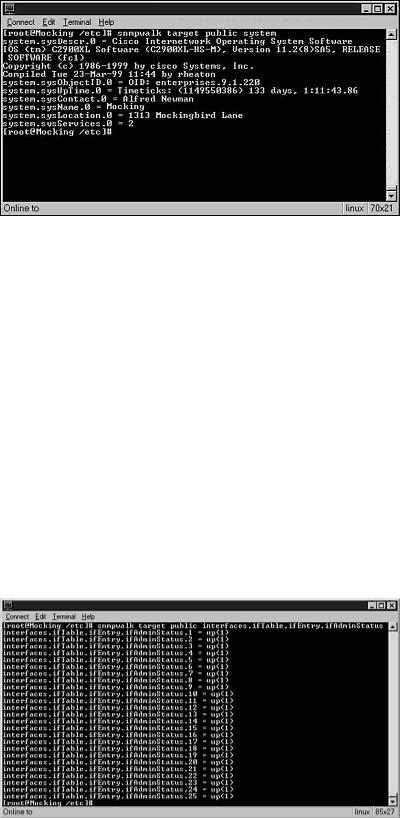
Looking at the results shown in Figure 17.8, we can see that this device is a Cisco 2900XL. It is running Version 11.2(8) of the IOS software. The system type and the version of the software could be checked against known exploits to launch further attacks against the device. The system contact is Alfred Newman, and it is located at 1313 Mockingbird Lane. Using this information, an attacker could call an organization posing as Alfred Newman and try to gain further information or even logins and passwords.
Snmpset invokes the set PDU that is used to change the value of writeable MIB variables. This can be used to create a Denial of Service by changing the configuration of an interface. For example, we can use snmpwalk to gain interface information about the target using the command snmpwalk
target public interfaces.ifTable.ifEntry.ifAdminStatus, which gives us the output shown in Figure 17.9.
Figure 17.9. Output from running the Snmpwalk program to gather interface information.
Using this information, we could change any of the twenty five interfaces’ ifAdminStatus from 1 (up) to 2 (down). In Figure 17.10, we use the command, snmpset target private
“Hackers Beware “ New Riders Publishing |
694 |
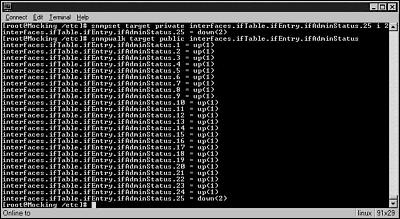
interfaces.ifTable.ifEntry.ifAdminStatus.25 i 2 to bring the twenty fifth interface down.
Figure 17.10. Output from running Snmpset from a DOS prompt.
The snmpwalk command run after snmpset confirms that the ifAdminStatus of interface twenty five was changed to down. This could disconnect the device from the network causing an outage. Recovering from this attack could be extremely difficult if all the system’s interfaces are taken off the network because it would force the system administrator to be physically in front of the device to resolve the problem.
WS Ping Pro Pack
WS Ping Pro Pack provides a finished Windows product with a sharp GUI that makes it very easy to gather SNMP information. Simply open WS Ping Pro, click the SNMP tab, and then enter an address of the SNMP agent and community string. Clicking the “What” drop-down box enables the users to select the specific MIB object or group of objects to scan. Selecting “Get all Subitems” will walk all the MIB objects after the object selected in the “What” box. In Figure 17.11, we walk the MIBs of the system target using WS Ping Pro.
Figure 17.11. WS Ping Pro pack using the SNMP Object Selector feature.
“Hackers Beware “ New Riders Publishing |
695 |
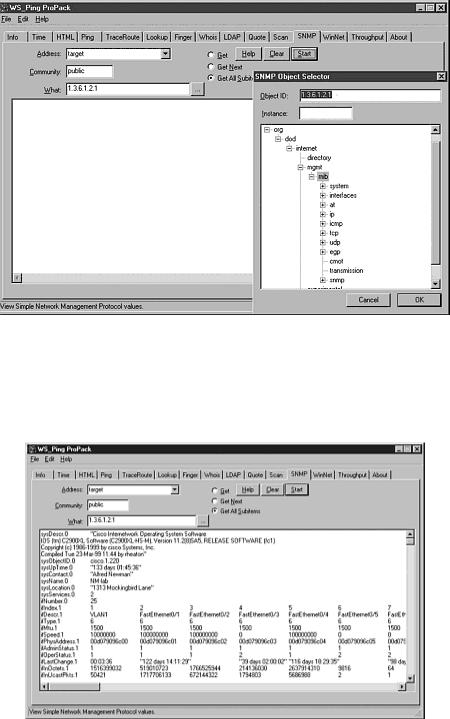
Selecting start from the window shown in Figure 17.11 walks though the MIBs and produces the output shown in Figure 17.12.
Figure 17.12. Listing of the MIBs available for a particular device using WS Ping Pro.
In this example, WS Ping was run against a Cisco 2924XL, which is a twenty four port switch and is shown in Figure 17.13.
Figure 17.13. Drawing of a Cisco 2924XL twenty four port switch.
“Hackers Beware “ New Riders Publishing |
696 |
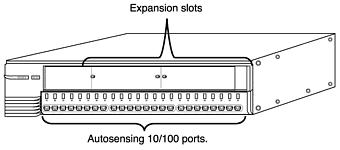
Figure 17.13 can be compared with the output of the first five ports from WS Ping:
ifIndex.1 |
1 |
|
2 |
3 |
4 |
5 |
FastEthernet0/2 |
|
ifDescr.1 |
VLAN1 |
FastEthernet0/1 |
||||||
FastEthernet0/3 |
|
FastEthernet0/4 |
6 |
|
|
|||
ifType.1 |
6 |
|
6 |
6 |
6 |
1500 |
1500 |
|
ifMtu.1 |
1500 |
|
1500 |
|
1500 |
|
||
ifSpeed.1 |
10000000 |
|
100000000 |
|
100000000 |
0 |
||
100000000 |
|
|
00d079096c00 |
00d079096c01 |
|
|||
ifPhysAddress.1 |
|
|
||||||
00d079096c02 |
|
00d079096c04 |
|
|
|
|||
00d079096c03 |
|
1 |
1 |
|
||||
ifAdminStatus 1 |
|
1 |
1 |
1 |
|
|||
ifOperStatus.1 |
|
1 |
1 |
1 |
2 |
1 |
|
|
The output of WS Ping almost matches the physical layout of the device, which helps to paint a picture in the user’s mind. By reviewing this output, we can see that the first port is a virtual interface, and ports two through five correspond to the first four physical interfaces on the switch. The MIB ifType.1 has a value of 6, which indicates all the interfaces are Ethernet. IfMtu.1 shows the maximum transmission unit for each interface and the ifSpeed.1 shows that four of the 5 interfaces are configured for 100 Mbps. IfPhysAddress.1 corresponds to the MAC address for each interface. The ifAdminStatus is a writeable MIB that can be configured to bring the interface up (value=1), down (value-2), or in a test mode (value=3). IfOperStatus.1 is an MIB that is closely related to ifAdminStatus. IfAdminStatus can be thought of as a desired state where ifOperStatus reports the actual status. An ifOperStatus value of 1 indicates that the interface is up, 2 indicates that the interface is down, 3 indicates that the interface is in a test mode, 4 indicates an unknown status, and 5 is a dormant value.
Signature of the Attack
An attack using the SNMP exploit can by identified by observing unauthorized systems trying to access hosts on your network using the
“Hackers Beware “ New Riders Publishing |
697 |
UDP port 161. You can see an attempt in the following log entry from the Linux firewall package Ipchains.
Aug 10 19:15:59 cm-192-168-20-2 kernel: Packet log: bad-if DENY eth0
PROTO=17 162.168.10.38:1097 192.168.202:161 L=132 S=0x00 I=59140 F=0x0000
T=128 (#10)
The field PROT=17 indicates the UDP protocol, and 162.168.10.38:1097 shows an attempt to connect to port 161. Further examination of this unauthorized traffic would reveal that the unauthorized client is trying to use public or private as community strings.
Authorized SNMP gathering systems are internal network management platforms, such as IBM’s Tivoli, Concord’s Nethealth, or Network Associates’ Router PM. which use SNMP to track availability and utilization of network devices.
How To Protect Against It?
The best defense against the SNMP exploit is to turn off SNMP on all devices. Because this is not an option in many companies and network installations, there are several steps that a security manager can take to limit the threat.
1.Treat all community strings as passwords and use the same policies as for other passwords.
1.Set a minimum number of characters, at least 8, the larger the better.
2.Require alphanumeric, numeric, and special characters.
3.Enforce password changes every 60 or 90 days.
4.Use snmputil or other such programs to validate community names and policies.
2.Set communities for read only access.
3.Do not use the same community on all devices.
4.Filter out SNMP ports (161, 162) on all Ingress routers.
5.Restrict access on SNMP devices, access lists on routers, and other similar filters on as many devices as possible. Allow only the assigned management station IP addresses.
6.Know your network devices and how SNMP is implemented on them if it is.
Other measures to help protect against the exploit include:
“Hackers Beware “ New Riders Publishing |
698 |
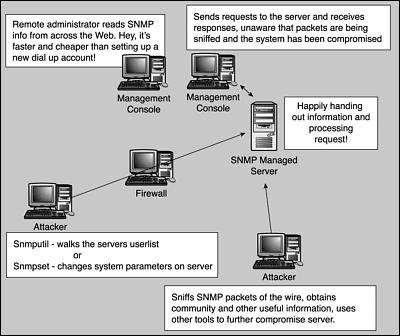
•Check for network interface cards running in promiscuous mode (sniffers).
•Keep your systems up-to-date on patches and fixes. Regularly check vendor Web sites for patches, fixes, and bulletins.
•Monitor system and other logs. Watch your SNMP monitor for traps!
Diagram
Figure 17.14 helps to illustrate how SNMP can be attacked from inside or outside the network and how most networks are wide open to these attacks. It may seem like a major design flaw, which it is, but leaving SNMP ports (UDP 161 & 162) open through a firewall and perimeter router, so that staff from parent companies or a central management facility can see your network, is common. One of my former clients, a DOD site, was doing this. They also had NetBIOS open to the world to share calendars and such!
Figure 17.14. Diagram of an SNMP attack.
Source Code/Pseudo Code
Snmpwalk and WS Ping Pro Pack all use an algorithm similar to the following:
while not error begin
getnext MIB
print MIB MIB-value
“Hackers Beware “ New Riders Publishing |
699 |
